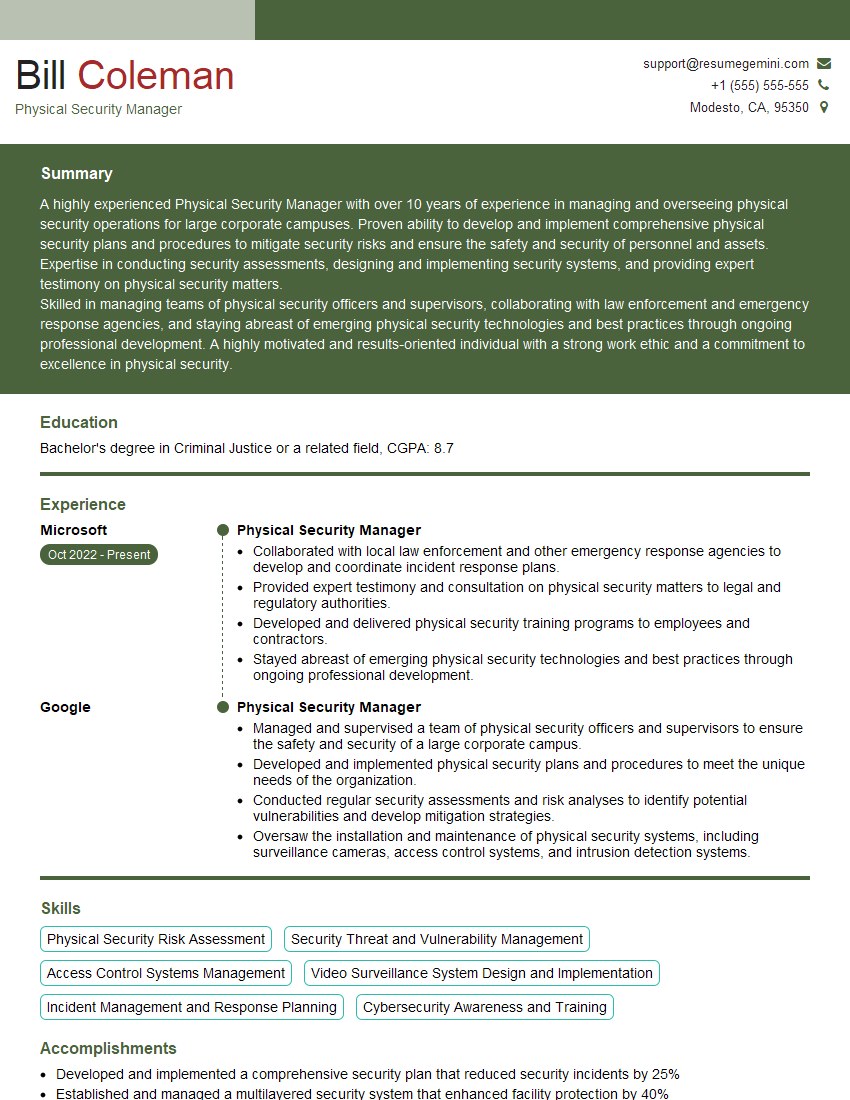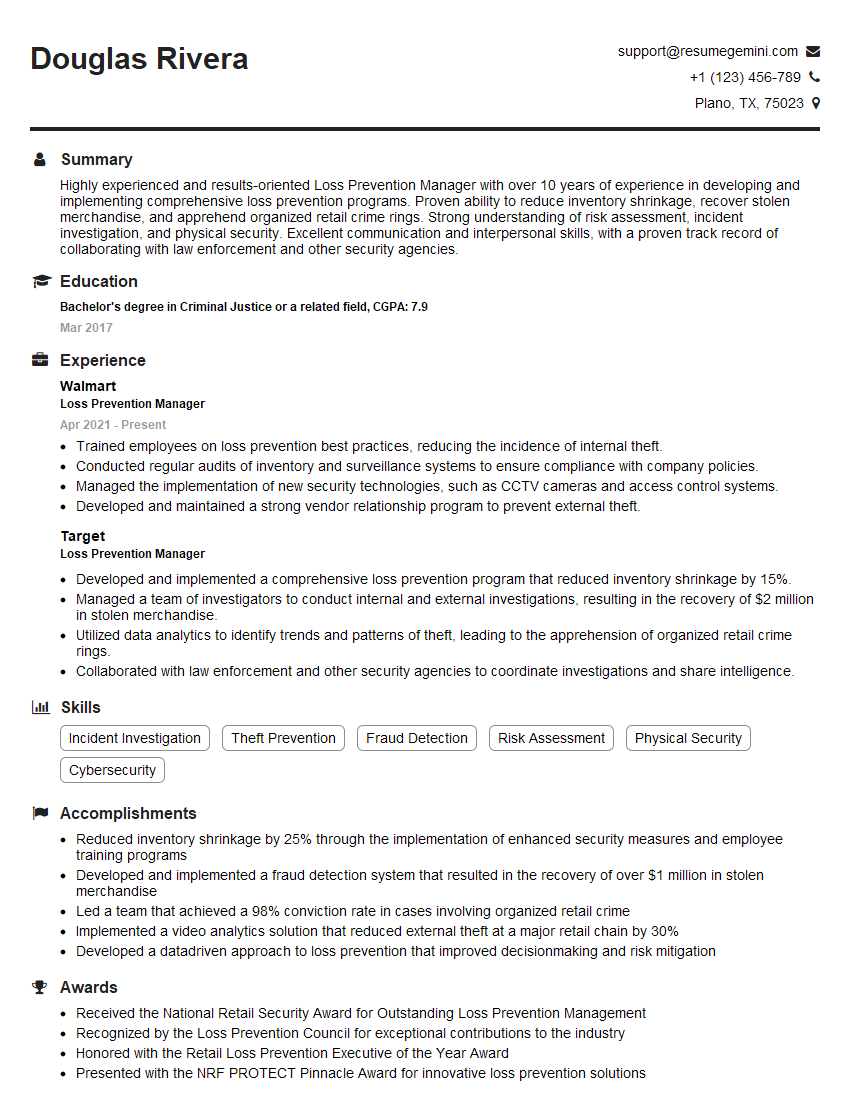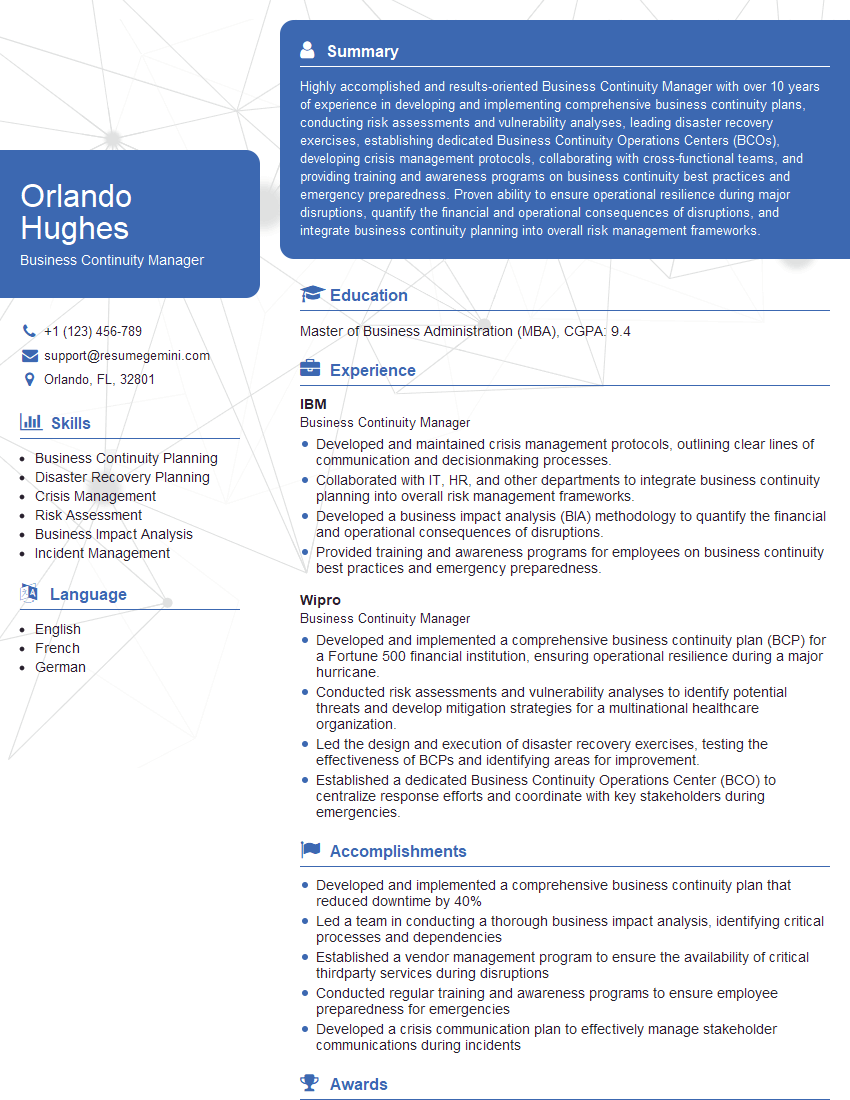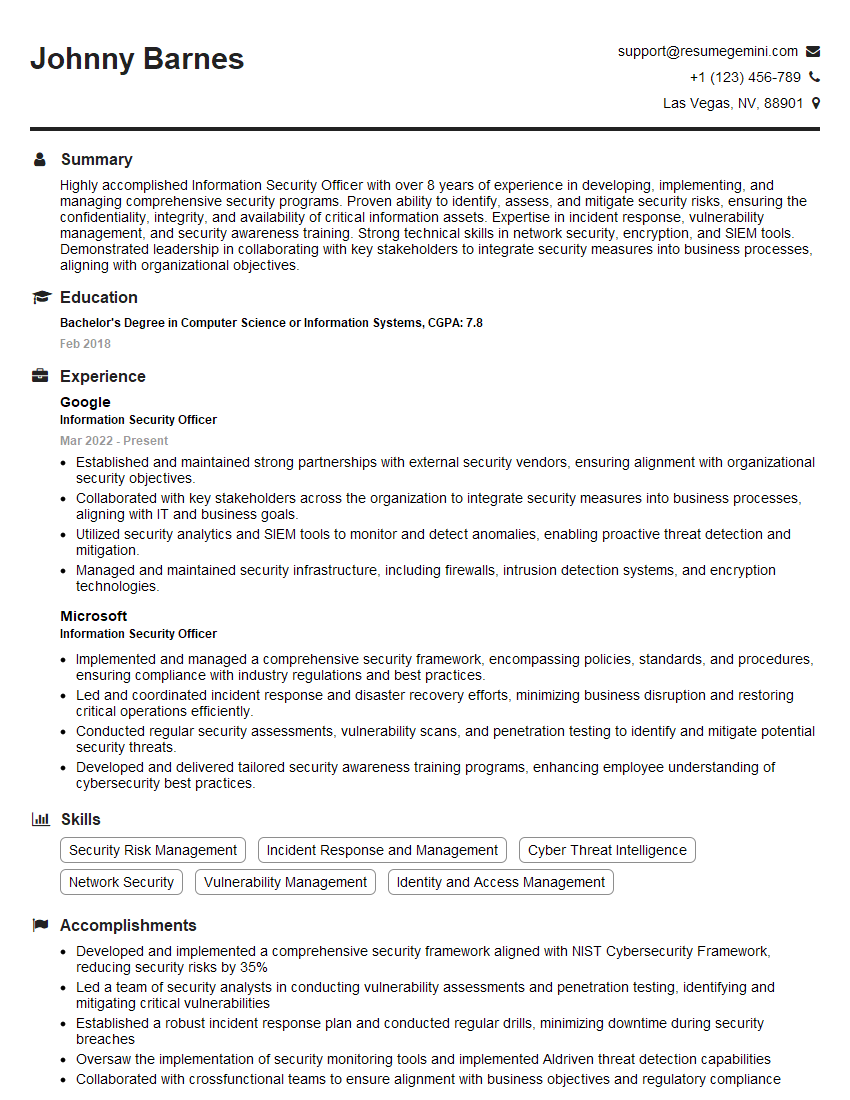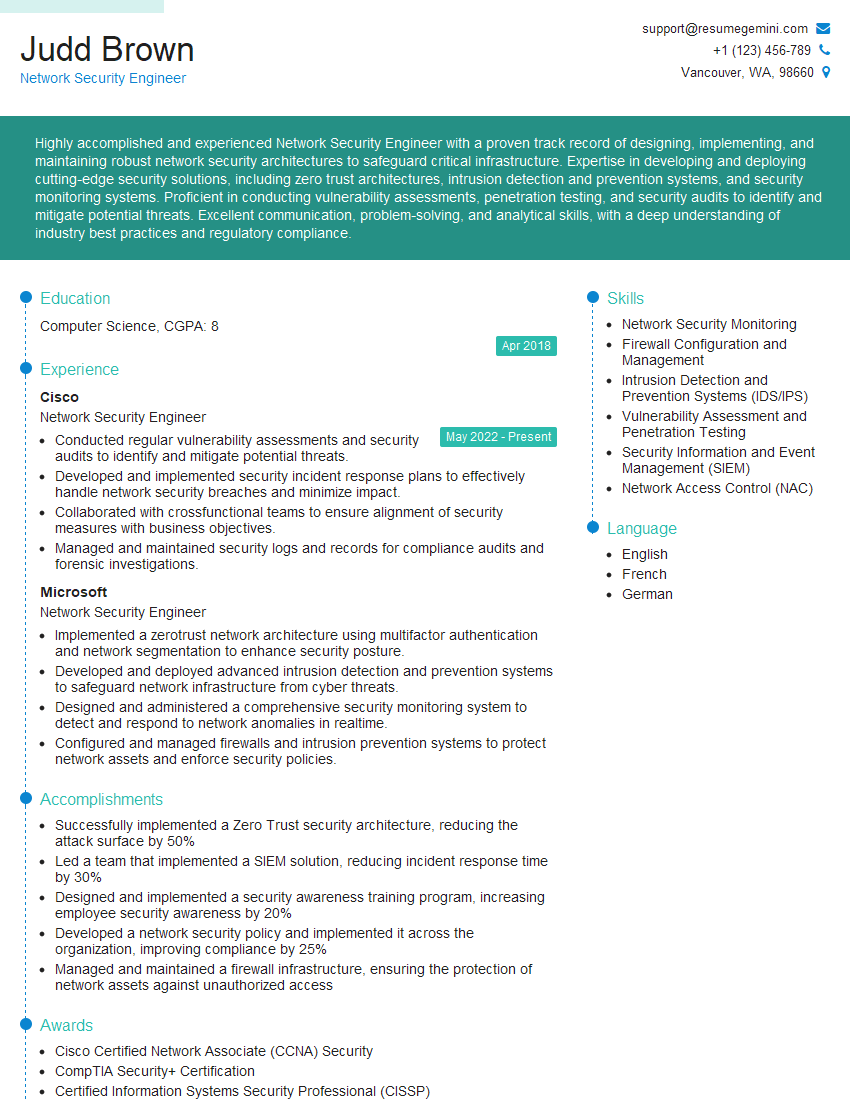Feeling uncertain about what to expect in your upcoming interview? We’ve got you covered! This blog highlights the most important Defensive Maneuvering interview questions and provides actionable advice to help you stand out as the ideal candidate. Let’s pave the way for your success.
Questions Asked in Defensive Maneuvering Interview
Q 1. Describe your experience in implementing defensive maneuvering techniques.
My experience in implementing defensive maneuvering techniques spans over a decade, encompassing various roles within cybersecurity, from incident response to security architecture design. I’ve worked with organizations across multiple sectors – finance, healthcare, and government – each presenting unique challenges and requiring tailored defensive strategies. For instance, in the financial sector, I led the implementation of a multi-layered security approach that incorporated advanced threat detection, intrusion prevention systems, and robust security information and event management (SIEM) capabilities. This involved not only the technical implementation but also extensive employee training on security awareness and best practices. In the healthcare sector, I focused on ensuring HIPAA compliance while simultaneously fortifying defenses against ransomware attacks, a significant threat in this field. These experiences have provided me with a deep understanding of the practical application of defensive maneuvering across diverse contexts.
Q 2. Explain the concept of layered security and its role in defensive maneuvering.
Layered security, in the context of defensive maneuvering, is like building a castle with multiple defensive walls. Each layer represents a different security control designed to impede attackers at various stages of their attempts to breach your systems. It’s about creating depth, not relying on a single point of failure. These layers can include perimeter security (firewalls, intrusion detection systems), network security (VPN, segmentation), endpoint security (antivirus, endpoint detection and response – EDR), data security (encryption, access control), and even human factors (security awareness training). The strength of layered security lies in its redundancy; if one layer fails, others are in place to mitigate the risk. For example, even if an attacker bypasses the firewall, the intrusion detection system might still detect their malicious activity, and endpoint security can prevent malware execution. This approach significantly increases the attacker’s cost and difficulty, forcing them to expend more resources and time, increasing the likelihood of detection and failure.
Q 3. How do you assess and prioritize threats in a dynamic security environment?
Assessing and prioritizing threats in a dynamic environment requires a structured approach. I utilize a combination of quantitative and qualitative methods. This includes using vulnerability scanning tools to identify weaknesses, threat intelligence feeds to understand emerging threats, and security event logs to analyze historical incidents. Prioritization is based on a risk assessment framework that considers the likelihood and impact of each threat. The likelihood is determined by factors such as the prevalence of the threat, the vulnerability of our systems, and the attacker’s capabilities. The impact considers the potential consequences of a successful attack, including financial loss, data breach, reputational damage, and legal repercussions. A threat with high likelihood and high impact is given the highest priority, often using a risk matrix to visually represent and communicate this assessment. This allows for focused resource allocation and effective mitigation strategies.
Q 4. What are the key principles of defensive maneuvering in a cyber security context?
Key principles of defensive maneuvering in cybersecurity involve proactive measures and reactive responses. These include:
- Proactive Defense: This involves identifying and mitigating vulnerabilities before attackers can exploit them. It relies on regular vulnerability assessments, penetration testing, and security awareness training.
- Layered Security: As mentioned earlier, creating multiple layers of defense to increase the difficulty for attackers.
- Defense in Depth: Deploying multiple security controls at each layer to provide redundancy and resilience.
- Threat Intelligence: Staying informed about emerging threats and vulnerabilities through threat feeds and security research.
- Incident Response Planning: Having a well-defined incident response plan to effectively handle security breaches.
- Reactive Defense: This involves rapidly responding to detected security incidents through containment, eradication, and recovery.
Q 5. Describe your experience in incident response and containment using defensive maneuvering strategies.
My experience in incident response and containment heavily utilizes defensive maneuvering strategies. For example, during a recent ransomware attack, we immediately implemented containment measures by isolating affected systems from the network to prevent further spread. Then, we analyzed the attack vector and eradicated the malware using specialized tools and techniques. Finally, we restored systems from backups and implemented enhanced security controls to prevent future attacks, including strengthening access control and improving employee security awareness. Throughout the process, I emphasized communication and collaboration with stakeholders to ensure transparency and coordinated action. Each incident provides valuable lessons learned, refining our response plan and strengthening our defensive capabilities.
Q 6. How do you develop and implement defensive maneuvering plans?
Developing and implementing defensive maneuvering plans involves a cyclical process. It starts with a thorough risk assessment to identify potential threats and vulnerabilities. Next, we define objectives, focusing on minimizing the impact of successful attacks and maximizing the time it takes attackers to achieve their goals. We then develop specific strategies and tactics, incorporating the principles of layered security and defense in depth. This often involves selecting and implementing security technologies, defining incident response procedures, and creating training programs for employees. Finally, we test and refine the plan through simulations and table-top exercises. Regular review and updates are crucial to adapt to evolving threats and technology changes. This continuous improvement loop ensures that the defensive maneuvering plan remains effective and relevant.
Q 7. Explain your understanding of risk assessment methodologies relevant to defensive maneuvering.
My understanding of risk assessment methodologies relevant to defensive maneuvering incorporates several frameworks. The widely used NIST Cybersecurity Framework provides a comprehensive approach to managing cybersecurity risk. It helps identify and prioritize threats, develop strategies to mitigate those risks, and implement appropriate controls. Another useful methodology is the FAIR (Factor Analysis of Information Risk) model, which offers a more quantitative approach to risk assessment by quantifying the likelihood and impact of various threats. I also leverage qualitative methods, like threat modeling, to analyze potential attack scenarios and identify vulnerabilities in our systems. The choice of methodology often depends on the specific context and the organization’s resources and capabilities. The key is to choose a methodology that allows for a thorough and well-informed risk assessment, informing the development of effective defensive maneuvering plans.
Q 8. How do you identify and mitigate vulnerabilities in a system using defensive maneuvering principles?
Identifying and mitigating vulnerabilities using defensive maneuvering involves a multi-layered approach focusing on proactive threat hunting and reactive incident response. We begin by understanding the system’s attack surface – all potential entry points for malicious actors. This includes network infrastructure, applications, endpoints, and even human factors. We use vulnerability scanners, penetration testing, and threat modeling to identify weaknesses. Once identified, we prioritize these vulnerabilities based on their severity and likelihood of exploitation, using frameworks like the Common Vulnerability Scoring System (CVSS). Mitigation strategies range from patching known vulnerabilities and implementing access controls to deploying intrusion detection/prevention systems (IDS/IPS) and employing security information and event management (SIEM) tools for continuous monitoring. A key element of defensive maneuvering is anticipating adversary tactics, techniques, and procedures (TTPs) to preemptively address potential exploits before they can be leveraged.
For example, if a vulnerability scanner reveals a critical vulnerability in a web application, we wouldn’t simply patch it. We’d also investigate if the application is properly configured, if input validation is strong enough, and if logging mechanisms are adequate to track potential exploitation attempts. We then implement a layered defense, including a web application firewall (WAF) to provide further protection even if the patch is momentarily delayed. This proactive approach ensures that even if one layer fails, others remain in place to thwart an attack.
Q 9. What are the common challenges faced when implementing defensive maneuvering strategies?
Implementing defensive maneuvering strategies presents several challenges. One significant hurdle is resource constraints – time, budget, and skilled personnel are often limited. Another challenge is the ever-evolving threat landscape. Attackers constantly develop new techniques, making it difficult to stay ahead of the curve. Keeping up with the latest threats, patching vulnerabilities promptly, and adapting strategies accordingly requires significant effort and ongoing investment. Furthermore, achieving effective collaboration across different teams (security, IT operations, development) is crucial for successful defensive maneuvering, but organizational silos and differing priorities can hinder this process. Finally, balancing security with usability is critical; overly restrictive security measures can negatively impact productivity and user experience, creating resistance to the implementation of security controls.
Q 10. Describe your experience in using threat intelligence to inform defensive maneuvering.
Threat intelligence plays a crucial role in informing our defensive maneuvering strategies. We leverage various sources, including commercial threat feeds, open-source intelligence (OSINT), and internal security logs to gain situational awareness. This intelligence helps us anticipate potential attacks, understand attacker TTPs, and prioritize vulnerabilities based on their likelihood of exploitation. For instance, if threat intelligence indicates a rise in ransomware attacks targeting a specific type of database software that we use, we immediately prioritize patching that software and strengthening its security configuration. We also adjust our security monitoring to detect early signs of compromise that are aligned with the observed TTPs. Threat intelligence-driven defensive maneuvering enables proactive and efficient resource allocation, helping us focus our efforts where they are most needed.
I recall a situation where threat intelligence alerted us to a new zero-day exploit targeting a specific web server component. Knowing this allowed us to immediately implement temporary mitigation strategies, such as adding stricter network rules, even before a patch was available. This prevented us from being caught off guard and significantly reduced our risk.
Q 11. How do you measure the effectiveness of defensive maneuvering strategies?
Measuring the effectiveness of defensive maneuvering requires a multifaceted approach. We track key metrics such as the number of successful attacks blocked, the time to detect and respond to incidents, the mean time to recovery (MTTR), and the reduction in the number of vulnerabilities identified. We also analyze security logs and incident reports to identify trends and areas for improvement. Regular penetration testing and vulnerability assessments help us validate the effectiveness of our security controls. Beyond quantitative metrics, we also conduct qualitative assessments, such as reviewing incident response reports, conducting post-incident analysis, and soliciting feedback from security personnel to identify areas for improvement in our defensive strategies. A key measure is whether our defensive posture successfully thwarted the attempts by threat actors or at least significantly delayed or minimized the impact of any successful attacks.
Q 12. Explain your understanding of different defensive maneuvering techniques, such as evasion, deception, and delaying tactics.
Defensive maneuvering techniques employ various strategies to thwart attackers. Evasion focuses on preventing detection. This could involve techniques like using encrypted channels or obfuscating malicious traffic to bypass intrusion detection systems. Deception aims to mislead attackers, often by deploying decoys or honeypots to distract them from critical assets while collecting intelligence about their methods. Delaying tactics slow down an attacker’s progress, buying time to implement countermeasures or gather more information. This can include implementing rate limiting on login attempts or deploying multi-factor authentication. These are not mutually exclusive; often, a successful defensive strategy integrates all three. For example, we might use deception to lure an attacker into a honeypot while employing delaying tactics to slow them down, all while actively working to evade their detection efforts.
Q 13. How do you communicate and collaborate effectively during a security incident requiring defensive maneuvering?
Effective communication and collaboration are paramount during a security incident. We utilize established communication channels, such as incident response playbooks and dedicated communication tools, to ensure clear and timely information flow. Roles and responsibilities are clearly defined, and regular updates are provided to stakeholders. We adhere to established protocols for escalating critical incidents and maintain detailed documentation throughout the incident response process. A common communication framework, perhaps using a standardized incident reporting template, is essential to maintain consistency and to minimize confusion during a stressful situation. This collaborative approach ensures that everyone is on the same page and can contribute effectively to mitigating the incident.
Q 14. Describe a situation where you had to adapt your defensive maneuvering strategy due to unforeseen circumstances.
In one instance, we were dealing with a sophisticated attack targeting our internal network. Our initial defensive maneuvering strategy relied on network-based intrusion detection. However, the attackers employed advanced evasion techniques that bypassed our IDS. We quickly realized that our initial strategy was insufficient. We had to adapt by integrating endpoint detection and response (EDR) solutions to provide a more comprehensive view of the attack. We also deployed deception techniques by deploying decoy systems to divert the attackers’ attention and gain valuable intelligence about their TTPs. This quick adaptation, based on our real-time analysis of the situation, allowed us to effectively contain the attack and prevent further damage. The key takeaway was the importance of remaining flexible and adjusting our strategy based on the adversary’s actions, rather than rigidly adhering to a pre-defined plan.
Q 15. What are some common indicators that a defensive maneuvering strategy needs to be adjusted?
Adjusting a defensive maneuvering strategy is crucial when the current approach fails to mitigate emerging threats or doesn’t align with evolving operational needs. Several key indicators signal the need for change.
- Increased security incidents: A noticeable rise in successful attacks, data breaches, or unauthorized access attempts suggests vulnerabilities in the existing strategy.
- New threat landscape: The emergence of sophisticated attack vectors, zero-day exploits, or novel malware necessitates adapting the defense mechanisms.
- Performance degradation: If security measures impede operational efficiency, negatively impact user experience, or introduce unacceptable latency, it’s time to optimize the strategy.
- Compliance failures: Non-compliance with industry regulations or internal policies highlights gaps in the defensive maneuvering plan requiring immediate attention.
- Security audits reveal weaknesses: Regular security audits often reveal shortcomings in the existing security posture, prompting a reassessment and improvement of the strategy.
For example, if a company experiences a significant increase in phishing attacks successfully bypassing their existing email security filters, this signals a need to strengthen employee training on phishing awareness and potentially implement advanced threat detection tools.
Career Expert Tips:
- Ace those interviews! Prepare effectively by reviewing the Top 50 Most Common Interview Questions on ResumeGemini.
- Navigate your job search with confidence! Explore a wide range of Career Tips on ResumeGemini. Learn about common challenges and recommendations to overcome them.
- Craft the perfect resume! Master the Art of Resume Writing with ResumeGemini’s guide. Showcase your unique qualifications and achievements effectively.
- Don’t miss out on holiday savings! Build your dream resume with ResumeGemini’s ATS optimized templates.
Q 16. How do you integrate physical security measures into a comprehensive defensive maneuvering plan?
Integrating physical security into a comprehensive defensive maneuvering plan is vital. It forms the first line of defense, complementing the digital security layers. This integration involves a layered approach.
- Perimeter security: Implementing strong perimeter controls like fences, gates, access control systems (ACS), and surveillance cameras restricts unauthorized physical access.
- Building security: Secure entry points, robust locks, alarm systems, and interior surveillance enhance building security. This might include multi-factor authentication for access to sensitive areas.
- Environmental controls: Protecting against environmental threats like fire, flood, and power outages is crucial. This includes fire suppression systems, backup power generators, and disaster recovery plans.
- Data center security: Data centers need stringent physical access controls, environmental monitoring, and robust security systems to safeguard sensitive data and equipment. This could include biometric scanners and specialized HVAC systems.
- Personnel security: Background checks, security awareness training, and clear access control policies help minimize insider threats and ensure responsible handling of physical assets.
Imagine a bank integrating physical security. They would have secured vaults, CCTV coverage, access control systems for employee entry, and robust alarm systems linked to law enforcement. This physical security works in tandem with network security and data encryption to form a complete defensive strategy.
Q 17. Explain your experience with various security technologies that support defensive maneuvering.
My experience spans various security technologies crucial for effective defensive maneuvering. I’ve worked extensively with:
- Intrusion Detection/Prevention Systems (IDS/IPS): These systems monitor network traffic for malicious activity and either alert (IDS) or block (IPS) suspicious connections. I’ve configured and managed both network-based and host-based IDS/IPS solutions.
- Firewall management: I possess deep expertise in configuring and maintaining firewalls, including rule optimization and advanced features such as application control and intrusion prevention.
- Endpoint Detection and Response (EDR): EDR solutions provide real-time visibility into endpoint activity, allowing for rapid threat detection and response. I’ve implemented and managed EDR solutions in various environments.
- Security Information and Event Management (SIEM): SIEM systems aggregate and analyze security logs from various sources, providing valuable insights into security events. I’ve used SIEM systems for threat hunting, incident response, and compliance reporting.
- Vulnerability scanners: Regular vulnerability assessments using automated scanners are essential. I have experience using several industry-standard vulnerability scanning tools and interpreting their reports to prioritize remediation efforts.
For instance, in a recent project, we implemented an EDR solution that detected and contained a sophisticated ransomware attack within minutes, preventing significant data loss.
Q 18. How do you stay updated on the latest threats and vulnerabilities relevant to defensive maneuvering?
Staying updated on the latest threats and vulnerabilities is paramount in the field of defensive maneuvering. I utilize a multi-faceted approach:
- Subscription to threat intelligence feeds: I subscribe to reputable threat intelligence feeds that provide real-time updates on emerging threats, malware, and vulnerabilities.
- Security blogs and forums: Regularly reading security blogs, participating in online forums, and following key security researchers allows me to stay abreast of the latest trends and discussions.
- Industry conferences and webinars: Attending industry conferences and webinars provides invaluable opportunities to learn from experts and network with peers.
- Vulnerability databases: I regularly check vulnerability databases like the National Vulnerability Database (NVD) to identify and address vulnerabilities in our systems.
- Security certifications and training: Pursuing relevant security certifications ensures that my knowledge remains up-to-date and aligns with industry best practices.
For example, by actively monitoring threat intelligence feeds, we were able to proactively patch a critical vulnerability in our web application before it could be exploited.
Q 19. Describe your familiarity with relevant security frameworks and standards (e.g., NIST, ISO 27001).
I’m familiar with several key security frameworks and standards, including:
- NIST Cybersecurity Framework: I understand its five core functions (Identify, Protect, Detect, Respond, Recover) and how they guide the development of a comprehensive cybersecurity program. I’ve used the framework to conduct risk assessments and develop remediation plans.
- ISO 27001: I’m knowledgeable about the requirements of this internationally recognized standard for information security management systems (ISMS). I’ve assisted organizations in achieving and maintaining ISO 27001 certification.
- CIS Controls: I understand the critical security controls outlined in the CIS framework and how they can be implemented to improve an organization’s security posture.
These frameworks provide a structured approach to building a robust and effective defensive maneuvering strategy. They offer a common language and set of best practices that facilitate collaboration and improve overall security effectiveness.
Q 20. How do you balance security measures with operational efficiency and user experience?
Balancing security measures with operational efficiency and user experience is a constant challenge. The key is to find the optimal balance that minimizes risk without sacrificing productivity or usability.
- Prioritization of risks: Focusing on mitigating high-impact risks first allows for efficient allocation of resources. This involves a thorough risk assessment to prioritize threats based on likelihood and impact.
- Automation: Automating repetitive security tasks, like vulnerability scanning and patch management, frees up resources and improves efficiency.
- User-centric design: Implementing security controls in a user-friendly manner minimizes disruption and enhances user acceptance. This might involve clear instructions, intuitive interfaces, and minimal friction.
- Continuous monitoring and improvement: Regularly monitoring the impact of security measures on operations and user experience allows for adjustments and optimizations over time.
For instance, instead of blocking all external access to a database, we could implement a secure gateway with detailed access controls and logging, allowing for safe access while maintaining operational efficiency and user experience.
Q 21. How do you train and educate others on defensive maneuvering best practices?
Training and education are essential for successful defensive maneuvering. My approach involves a multi-layered strategy.
- Security awareness training: Conducting regular security awareness training programs to educate employees about common threats, best practices, and the importance of security. This might include phishing simulations and interactive modules.
- Technical training: Providing hands-on technical training for security personnel on specific technologies and tools used in the defensive maneuvering plan.
- Incident response training: Equipping individuals with the skills to respond effectively to security incidents, through simulations and tabletop exercises.
- Documentation and knowledge sharing: Creating clear and accessible documentation of security policies, procedures, and best practices. This may involve creating an internal wiki or knowledge base.
- Gamification: Incorporating elements of gamification into security training can increase engagement and knowledge retention.
For example, I’ve developed and delivered security awareness training programs using interactive scenarios that simulate real-world phishing attacks, significantly improving employee awareness and reducing successful phishing attempts.
Q 22. Describe your experience in conducting security audits and assessments.
Security audits and assessments are crucial for identifying vulnerabilities and weaknesses in an organization’s defensive posture. My experience encompasses a wide range of methodologies, from penetration testing and vulnerability scanning to risk assessments and compliance audits. For example, in my previous role, I led a team that performed a comprehensive security audit of a financial institution’s network infrastructure. This involved identifying potential entry points for attackers, assessing the effectiveness of existing security controls, and recommending improvements to strengthen their overall security posture. Another significant project involved a security assessment of a critical manufacturing plant, focusing on industrial control systems (ICS) security and identifying vulnerabilities that could lead to disruption or sabotage. We used a combination of automated tools and manual analysis, culminating in a detailed report with prioritized recommendations for remediation. These projects involved close collaboration with IT teams and business stakeholders to ensure the audits were comprehensive and actionable.
Q 23. Explain your understanding of legal and regulatory compliance requirements related to defensive maneuvering.
Legal and regulatory compliance is paramount in defensive maneuvering. My understanding encompasses various frameworks like GDPR, CCPA, HIPAA, PCI DSS, and NIST Cybersecurity Framework. For instance, GDPR mandates specific data protection measures, impacting how organizations handle personal data and incident response. Non-compliance can result in hefty fines and reputational damage. Similarly, HIPAA’s stringent regulations on protected health information (PHI) dictate rigorous security controls for healthcare providers. Understanding these frameworks informs the design and implementation of defensive strategies. I have hands-on experience translating these abstract requirements into concrete security controls, such as implementing data encryption, access control mechanisms, and intrusion detection systems. I also stay updated on evolving legislation and regulations to ensure our defensive strategies remain compliant and effective.
Q 24. How do you handle conflicting priorities or competing demands during a security incident?
During a security incident, conflicting priorities are inevitable. My approach prioritizes a structured, risk-based response. Think of it like a triage in a hospital – the most critical issues get immediate attention. We use a prioritized incident response plan, focusing on containment, eradication, recovery, and post-incident analysis. For example, if we have a ransomware attack simultaneously impacting both critical systems and less-critical systems, we’d prioritize the critical systems first, aiming to limit the damage and ensure business continuity. Effective communication with stakeholders is vital. Transparent reporting keeps everyone informed and aligned, despite the pressures of a crisis. We often leverage a communication matrix outlining different stakeholder groups and their respective communication needs during an incident.
Q 25. Describe your experience in working with diverse teams and stakeholders.
Collaboration is fundamental to effective defensive maneuvering. I thrive in diverse team environments, working with IT professionals, security specialists, legal counsel, and business leaders. My experience includes leading cross-functional teams during both planned security initiatives and reactive incident response efforts. For example, during a recent phishing campaign, I collaborated with the IT team to identify compromised accounts, the legal team to manage legal implications, and the communications team to inform affected employees. I believe in fostering open communication and mutual respect; this enables effective collaboration and the sharing of diverse perspectives, critical for developing comprehensive solutions.
Q 26. What are some common mistakes to avoid when implementing defensive maneuvering strategies?
Implementing defensive maneuvering strategies without careful consideration can lead to several common mistakes. One frequent error is focusing solely on technology without considering the human element. Security awareness training and robust employee security policies are as crucial as firewalls and intrusion detection systems. Another pitfall is neglecting regular security assessments and updates. Security is an ongoing process, not a one-time project. Failing to update software, patch vulnerabilities, and regularly test security controls can leave systems exposed. Finally, overlooking the importance of incident response planning is a critical oversight. Having a well-defined and regularly tested plan is essential for effectively handling security incidents. In essence, a holistic approach combining technical, procedural, and human elements is crucial for success.
Q 27. How do you measure the return on investment (ROI) of your defensive maneuvering efforts?
Measuring the ROI of defensive maneuvering efforts requires a multi-faceted approach. It’s not just about calculating the cost of security measures; it’s about assessing the value of what those measures protect. We quantify this by calculating the potential cost of a security breach – lost revenue, legal fees, reputational damage, and recovery costs. This is compared against the cost of implemented security measures. For example, implementing multi-factor authentication might seem costly initially, but the potential savings from preventing a data breach far outweigh the investment. We also track key metrics like the number of successful phishing attacks prevented, vulnerabilities identified and remediated, and reduction in security incidents. These metrics offer valuable insights into the effectiveness of our defensive strategies and their impact on reducing risk and protecting business value.
Key Topics to Learn for Defensive Maneuvering Interview
- Risk Assessment and Mitigation: Understanding and evaluating potential threats, analyzing vulnerabilities, and developing strategies to minimize risks.
- Evasion Techniques: Practical application of techniques to avoid detection and engagement, including terrain masking, concealment, and deception.
- Obstacle Negotiation: Mastering techniques for safely navigating various obstacles, considering speed, safety, and efficiency.
- Communication and Coordination: Effective communication protocols and coordination strategies within a team during defensive maneuvers.
- Situational Awareness: Maintaining a constant awareness of the surrounding environment, identifying potential threats, and adapting strategies accordingly.
- Counter-Maneuvering: Anticipating and responding to opponent’s actions, effectively countering their offensive maneuvers.
- Technological Applications: Understanding how technology (e.g., sensors, communication systems) enhances defensive capabilities.
- Legal and Ethical Considerations: Awareness of legal and ethical implications of defensive actions.
- Post-Incident Analysis: Reviewing past maneuvers to identify areas for improvement and refinement of future strategies.
Next Steps
Mastering Defensive Maneuvering is crucial for career advancement in numerous fields demanding strategic thinking and risk management. A strong understanding of these principles will significantly enhance your job prospects and open doors to exciting opportunities. To maximize your chances of landing your dream role, it’s essential to create a compelling and ATS-friendly resume that highlights your skills and experience effectively. ResumeGemini is a trusted resource to help you build a professional resume that showcases your abilities in the best light. We provide examples of resumes tailored to Defensive Maneuvering to guide you in crafting a document that truly represents your expertise. Take the next step towards your career success – build a winning resume with ResumeGemini today.
Explore more articles
Users Rating of Our Blogs
Share Your Experience
We value your feedback! Please rate our content and share your thoughts (optional).
What Readers Say About Our Blog
Hello,
We found issues with your domain’s email setup that may be sending your messages to spam or blocking them completely. InboxShield Mini shows you how to fix it in minutes — no tech skills required.
Scan your domain now for details: https://inboxshield-mini.com/
— Adam @ InboxShield Mini
Reply STOP to unsubscribe
Hi, are you owner of interviewgemini.com? What if I told you I could help you find extra time in your schedule, reconnect with leads you didn’t even realize you missed, and bring in more “I want to work with you” conversations, without increasing your ad spend or hiring a full-time employee?
All with a flexible, budget-friendly service that could easily pay for itself. Sounds good?
Would it be nice to jump on a quick 10-minute call so I can show you exactly how we make this work?
Best,
Hapei
Marketing Director
Hey, I know you’re the owner of interviewgemini.com. I’ll be quick.
Fundraising for your business is tough and time-consuming. We make it easier by guaranteeing two private investor meetings each month, for six months. No demos, no pitch events – just direct introductions to active investors matched to your startup.
If youR17;re raising, this could help you build real momentum. Want me to send more info?
Hi, I represent an SEO company that specialises in getting you AI citations and higher rankings on Google. I’d like to offer you a 100% free SEO audit for your website. Would you be interested?
Hi, I represent an SEO company that specialises in getting you AI citations and higher rankings on Google. I’d like to offer you a 100% free SEO audit for your website. Would you be interested?
good
